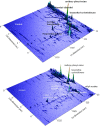The dialogue between protozoa and bacteria in a microfluidic device
- PMID: 31596855
- PMCID: PMC6784911
- DOI: 10.1371/journal.pone.0222484
The dialogue between protozoa and bacteria in a microfluidic device
Abstract
In nature, protozoa play a major role in controlling bacterial populations. This paper proposes a microfluidic device for the study of protozoa behaviors change due to their chemotactic response in the presence of bacterial cells. A three-channel microfluidic device was designed using a nitrocellulose membrane into which channels were cut using a laser cutter. The membrane was sandwiched between two glass slides; a Euglena suspension was then allowed to flow through the central channel. The two side channels were filled with either, 0.1% peptone as a negative control, or a Listeria suspension respectively. The membrane design prevented direct interaction but allowed Euglena cells to detect Listeria cells as secretions diffused through the nitrocellulose membrane. A significant number of Euglena cells migrated toward the chambers near the bacterial cells, indicating a positive chemotactic response of Euglena toward chemical cues released from Listeria cells. Filtrates collected from Listeria suspension with a series of molecular weight cutoffs (3k, 10k and 100k) were examined in Euglena chemotaxis tests. Euglena cells were attracted to all filtrates collected from the membrane filtration with different molecular weight cutoffs, suggesting small molecules from Listeria might be the chemical cues to attract protozoa. Headspace volatile organic compounds (VOC) released from Listeria were collected, spiked to 0.1% peptone and tested as the chemotactic effectors. It was discovered that the Euglena cells responded quickly to Listeria VOCs including decanal, 3,5- dimethylbenzaldehyde, ethyl acetate, indicating bacterial VOCs were used by Euglena to track the location of bacteria.
Conflict of interest statement
The authors have declared that no competing interests exist.
Figures










References
-
- Vaerewijck MJM, Baré J, Lambrecht E, Sabbe K, Houf K. Interactions of Foodborne Pathogens with Free-living Protozoa: Potential Consequences for Food Safety. Comprehensive Reviews in Food Science and Food Safety. 2014;13(5):924–44. 10.1111/1541-4337.12100 - DOI
-
- Zubkov MV, Sleigh MA. Bacterivory by the ciliate Euplotes in different states of hunger. FEMS Microbiology Ecology. 1996;20(3):137–47. 10.1016/0168-6496(96)00018-9. - DOI
-
- Pachiadaki MG, Taylor C, Oikonomou A, Yakimov MM, Stoeck T, Edgcomb V. In situ grazing experiments apply new technology to gain insights into deep-sea microbial food webs. Deep Sea Research Part II: Topical Studies in Oceanography. 2016;129:223–31. 10.1016/j.dsr2.2014.10.019. - DOI
-
- Pernthaler J. Predation on prokaryotes in the water column and its ecological implications. Nat Rev Micro. 2005;3(7):537–46. - PubMed
Publication types
MeSH terms
Substances
LinkOut - more resources
Full Text Sources
Molecular Biology Databases

